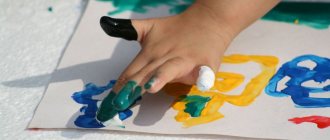Children's "scribbles" are nothing more than an effective way to develop a child's fine motor skills and artistic taste. When drawing, the child’s imagination grabs hold of the images and transforms them into dashes/dots/blots. In general, one cannot underestimate all the benefits of this simple but very exciting activity.
You can start drawing with your child from 8-9 months: first with finger paints, then adding other tools. By the age of 2-3, the child already clearly understands what this process is and understands the meaning of color and shape.
If your child sits at home or goes to a nursery, then you will have to act as an art teacher (as a rule, in a nursery with kids they draw “anyhow” - too “troublesome” activity).
What will you need for drawing?
How can a child draw?
Don't be afraid to experiment with different tools. Anything that leaves a mark can be used for your activities.
Standard means:
- Finger paint. Price - from 250 rubles. You can find many recipes online on how to make similar paints yourself.
- Wax pencils and crayons.
- Ordinary crayons. Draw on asphalt, slate, pebbles, etc.
- Lead pencils.
- Paints: watercolor, gouache.
- Markers and felt-tip pens.
Some mothers say that it is too early to give pencils and thin felt-tip pens to a child at the age of 2, since due to “light child pressure” the lead will break and the rods will be pressed in. But the argument in favor is the provision of choice, variety, assortment. Don't skimp on markers and pencils (and don't buy the cheapest ones, which are really bad for drawing).
In stores like “Fix Price” you can sometimes buy some unusual drawing supplies. Let this be a one-time activity, but variety (I repeat) is very important. For example, a kit for painting with glitter on velvet paper. Or markers that you need to blow into.
Oil crayons (pastel)
This material should not be confused with the wax crayons that we had in our childhood. Wax crayons were based on wax; they did not write brightly and required effort. Oil pastels are distinguished by their softness and bright colors and can become the first drawing material for a child aged 2-3 years. You can draw absolutely anything with these crayons: mom, dad, cars, clouds, landscape.
The disadvantage of oil crayons is their fragility: you cannot drop them, throw them, press them hard, stand on them or sit on them.
As for color palettes, it is, of course, better to take a set right away, but one intended specifically for children, and not for professional artists. For the first time, 6-12 primary colors will be enough. Most often, each chalk is packed in a paper or plastic wrapper to prevent your hands from getting dirty. And some crayons have the shape of a pencil, which is even more convenient for drawing.
For your first creative activities, there is no need to buy special paper; regular printer paper will do.
What to draw on?
Most often, children are offered A4 sheets. This is a fairly budget option, taking into account the fact that a child can draw one line with a brush across the entire sheet and demand a clean one for a new “plot”. But it will be great if the drawing lesson is held on a large sheet of whatman paper laid out on the floor. “Large drawing” is very useful for a child. He is still just mastering the world around him and the “ways of influencing” it. It is quite possible that he will want to paint himself. Or walk with your decorated feet on the floor, while experiencing extraordinary delight.
Instead of expensive sheets of whatman paper, you can use a roll of cheap white paper wallpaper.
In addition to paper, you will have to stock up on: sippy cups (sometimes you can set out larger dishes with water), a palette for mixing paints. It will be very good if you have a double-sided board in your house (on one side you can draw with chalk, on the other with markers).
Pencils
Another material that not everyone likes. Compared to oil-based crayons, pencils are harder and require effort to achieve rich, vibrant color. But, of course, in order to decide which material is most convenient for your child to draw with, it is still worth buying the first pencils.
Choose soft triangular ones with a small number of colors in the set (12 colors are enough to decide whether you like it or not). Some manufacturers produce special sets for the smallest: they are triangular, with an increased diameter and with a large rod.
What and how to draw with a child aged 2-3 years?
A two-year-old child is able to repeat simple visual shapes: lines, dots, circles, triangles, polygons. If you are studying the alphabet, then also letters (a separate material will be devoted to this topic).
At this age, children already understand that they can depict the world around them on paper. Adults are often asked to draw something specific, and they begin to make attempts to do it themselves.
From the author: my daughter did not yet know how to speak, but she drew a wavy line and said “sh-sh-sh,” which means “snake.”
— A child can paint over the shapes drawn by an adult . Shading (shading) is a good way to quickly master a tool and develop hand-eye coordination. And even if the shading “goes” beyond the boundaries at first, over time the baby will get better and better.
To interest your child, you can come up with games and stories. Draw a mouse and a cat. “Oh, the cat is about to catch the mouse!” Let's help her hide!
— Drawing lines. Playing trail games is also very interesting. Draw animals on one edge of the sheet and the food they eat on the other. For example: mouse, squirrel, hare and cheese, nut, carrot. Offer to draw paths along which each animal can walk to its lunch.
— Drawing points. Rain, grains for a chicken, sand on the beach, seeds in a ripe watermelon - these and other scenes can be played out to teach a child to put dots. At the same time, pay attention to the pressure, tell your child what the result will be if you press the pencil harder/weaker.
— Stamping. In FixPrice stores or in stationery departments you can buy simple stamps with animal figures, leaves, and drops. Teach your child to use them, and then “draw” your story. In addition to prints, a story can “contain” sticker characters.
You can make your own stamps. Cut out a figure from a PVC packaging substrate (greens and packaged confectionery products are sold on such substrates in stores). Glue onto a piece of foam using a hot glue gun. The foam should be of such a shape and size that it is comfortable for the child to hold it. Soak a sponge in colored water or ink to color the stamp.
— Using an eraser. Show how to use an eraser. “Here is the path (draw with a simple pencil). Winter came, a strong wind blew, it covered the path with snow and it became invisible.” You can come up with other stories.
Another great erasing exercise: draw with chalk on a slate board, give your son/daughter a brush and a glass of water. The task is to erase the drawn lines with a wet brush. If this seems a little complicated for now, then wiping it with a regular rag will definitely do!
— Drawing from a stencil, tracing figures. The child himself will be able to draw from a stencil when he is closer to 3 years old and older. But at 2 it’s not too early to start introducing him to this method of depicting objects! Start tracing arms, legs... maybe the baby will lie down completely on whatman paper and you will trace him - it’s so exciting! Show how to trace stencils outside and inside (cut out the shapes yourself from thick cardboard; the edges can be covered with tape to last longer).
An alternative way to work with a stencil is to use a roller. Dip a roller (small size) into the paint and roll it over the surface of the paper inside the stencil. Let the baby repeat. It doesn’t matter if it goes abroad a lot, the drawing will still turn out good.
Most importantly, don't limit yourself to the lessons provided! Use your imagination, play with your baby, help him develop his sense of beauty and transfer what he has in mind to paper. Here are some more ways to draw.
Workplace
Before starting drawing lessons, set up a comfortable workspace for your child. Drawing on a stack of books in the mother's arms will either discourage the child from drawing at all, or will encourage him to choose a more comfortable place, for example, on the wall or on the carpet.
For the little ones, choose children's tables with adjustable heights, as well as adjustable chairs. You shouldn’t immediately buy your child an easel—not everyone likes to draw on it. But many people strive to “decorate” their wallpaper with a pattern, so a place for painting can also be arranged on the wall. For example, hang a large sheet of Whatman paper or a special board for chalk.
In any case, it is your child who should choose the material for drawing, and not you, otherwise, if the child doesn’t like something, you can discourage all desire for further creativity.
Examples of custom drawing
The methods can be adapted for younger and older children.
Drawing on sand/semolina with a finger/stick.
All kids like this method. It develops fine motor skills and tactile sensitivity. If possible, build something like a light cube - a box with a transparent lid with a light bulb inside. Drawing on a thin layer of sand on such a box is very entertaining.
Coloring crafts made from salt dough.
After modeling, you may end up with various figures that your child will be happy to paint. If he still doesn’t understand well that mixing all the colors in a row will only result in “dirt,” give him one jar of paint at a time. Then, when the drawing on the figure dries, take out the next color.
Drawing with crayons on stones.
If you go to the sea or to a rocky beach in the summer, be sure to take a box of crayons with you. While you are sunbathing, your baby will have something to do - coloring rock candy.
Drawing with colored ice.
This activity is especially relevant for hot summer days. Freeze ice cubes by adding colorful paints to the water (regular watercolor will do). Place your child on a piece of Whatman paper and give him a container of colored ice. Having coped with the task of removing the cold cubes, he will move them around the paper until they melt.
Use of available materials.
Draw with everything you can get your hands on! (Well, or almost everyone...) Study the result, comment, discuss with your child. You can dip glass balls in paint and roll them inside the box: let the child tilt the box to the sides and follow the multi-colored trace. You can use a fork to draw a lion's mane, spruce paws, or hedgehog needles. And so on!
If your son is passionate about cars, dip the wheels in paint and let him “drive” his vehicle on a piece of whatman paper. And you help him draw a road, trees along the road, a traffic light and a pedestrian crossing.
Drawing as part of the game.
Combine drawing with other activities: appliqué, paper crafts, and natural materials. Maybe you have fabric paints at home? Buy a white T-shirt and let your child design it himself! You can print his palms on a T-shirt - not only will it be a drawing activity, but it will also be a memory for many years.
Paints
Two types of paints are relevant for children: watercolor or gouache. Some people get used to one type, while others like others. In any case, you need to try to understand.
As for watercolors, few recommend it as the first paints, although modern manufacturers produce sets designed specifically for the little ones (the so-called honey watercolor). These are safe water-soluble paints that are suitable as the first ones. They are based on no toxic substances, given that a child may accidentally lick the brush. Good for coloring and economical.
Gouache should be chosen from the age when the child stops putting everything in his mouth (gouache is not one of those paints that can be tasted). Painting with gouache is pleasant if you choose the right brand (by the way, we always bought gouache from Gamma or Luch and did not regret it, but in both series, according to reviews, there are cheap sets with dirty shades). Low-quality paints will not fit well on paper and mix unsightly, sometimes forming sediments and clumps, which will definitely discourage you from painting with gouache. So make your choice responsibly.
Other types of paints (acrylic, tempera, oil) are considered more professional and are not recommended for children at first.
The most important rule of drawing with a baby!
Have enough patience and don't get irritated while painting with your two year old! Even if he, expressing a desire to draw, forced you to unscrew 8 caps from the gouache, and then a minute later switched to another activity. Just close the jars and put them away until next time, but under no circumstances reproach your child or force him to draw with force. Believe me, only in this case there will be real benefits from the classes!
Add your drawing methods in the comments. Let's help our kids grow up smart and with a developed artistic taste!
If you are interested in learning other ways to develop fine motor skills, you can read about playing with cereal here.
I want to show our drawings in the nursery. There are not many of them (since adaptation to kindergarten took place with “frequent snot”), but you can see what is offered to kids in kindergarten. For those interested, look at examples of drawing in a nursery.
Markers
One of the favorite materials for any child: they leave a bright mark and do not require special pressure. And in our childhood, these were some of our favorite materials for drawing due to their color palette.
The disadvantage of regular felt-tip pens is their durability on various surfaces (for example, on walls), so for children under 3 years old it is better to choose washable felt-tip pens. But the cost of these will be much higher than usual.
Choose the color palette as you wish: some parents prefer to go with more expensive ones, but with fewer colors, while others prefer a variety of colors. But to prevent both markers from drying out, you need to teach your child to always close the caps.
Felt pens for little ones usually have a triangular cross-section (for easier grip) and a rounded tip of the rod.
As for the paper, regular printer paper will also work, but fresh markers can leak onto the other side, so you need to put something under the paper to prevent the table surface from staining.
For older children, you can try buying art markers (a modern material based on alcohol and pigment), which are considered a more professional material.
Why does my child draw everything black?
Many kids draw with a black, brown or simple pencil; they like to draw with a pen. It's not scary. It’s just that this drawing turns out clearer and brighter. At an early age, color is not as important as it is for older children.
The main thing for them is that the drawing stands out against the general background. Black is clearly visible on white.
Children are all different. How can I find out about my child’s special needs?
System-vector psychology of Yuri Burlan distinguishes people by vectors. There are eight of them in total. Each person, including a child, has from 1 to 8 vectors; today, people with 3-6 vectors are most often found. Vectors determine the characteristics and differences of children.
Activists and “Hustlers”
Children with the skin vector are active, mobile, restless. They do everything quickly, but not very carefully. Fidgets. If they sculpt, they will sculpt everything around. If they draw, then they draw action. Often drawn with a simple or black pencil. They prefer expressive, “fast” drawings. Ideally they do not draw or paint over objects. They may not finish their work and easily switch to a new topic.
It is easier for these kids to sculpt and make crafts; such artistic activities are more suitable for their activity. However, they still need to learn discipline and control over their actions. In drawing, the process is easier to control with materials such as pencils, crayons, and felt-tip pens.



